|
Nothing Cut and Dried About
Collecting Cookie Cutters
by Bob Brooke
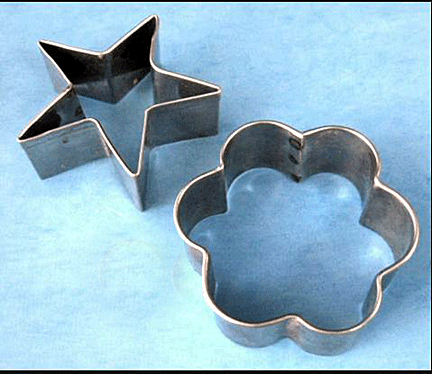 Tis
the season for baking cookies, not just for Christmas, but for all the
other holidays at this time of year. And, let’s face it, they’re comfort
food that not only warm a person’s tummy but also warm up the kitchen as
they’re baking. At the heart of many cookies, especially those delicious
sugar varieties, lies the cookie cutter. Tis
the season for baking cookies, not just for Christmas, but for all the
other holidays at this time of year. And, let’s face it, they’re comfort
food that not only warm a person’s tummy but also warm up the kitchen as
they’re baking. At the heart of many cookies, especially those delicious
sugar varieties, lies the cookie cutter.
The common perception of cookie cutters, strictly speaking, is that
they’re devices used to cut rolled dough into shapes before baking. But
that’s only the beginning of the story.
Cookie Cutter History
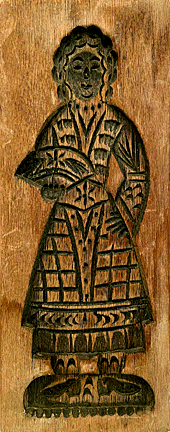 Carved
wooden cookie cutters go back thousands of years. The earliest cutters
for pastries and cookies, or "biscuits" as the English call them, were
imprinted designs on the surface of dough. English bakers used these
“imprint cutters,” first made in Italy, starting in the 15th century to
make gingerbread figures in the shape of celebrities like Queen
Elizabeth I or Lord Wellington. Outline cutters, made from a flat piece
of bent wood like pear, walnut, or beech, with a cutting edge and
handle, followed them. Carved
wooden cookie cutters go back thousands of years. The earliest cutters
for pastries and cookies, or "biscuits" as the English call them, were
imprinted designs on the surface of dough. English bakers used these
“imprint cutters,” first made in Italy, starting in the 15th century to
make gingerbread figures in the shape of celebrities like Queen
Elizabeth I or Lord Wellington. Outline cutters, made from a flat piece
of bent wood like pear, walnut, or beech, with a cutting edge and
handle, followed them.
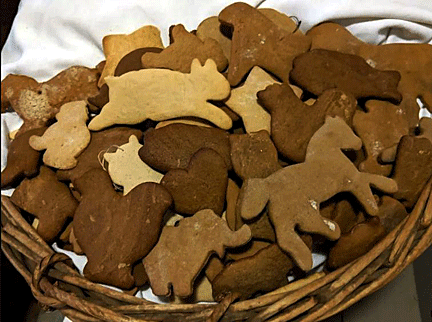 Beginning
in the 17th century, Dutch and German settler housewives in Pennsylvania
made large batches of cookies in a variety of shapes, including doves,
cockerels, human figures such as Belznickel, and the bald eagle for
Christmas. Beginning
in the 17th century, Dutch and German settler housewives in Pennsylvania
made large batches of cookies in a variety of shapes, including doves,
cockerels, human figures such as Belznickel, and the bald eagle for
Christmas.
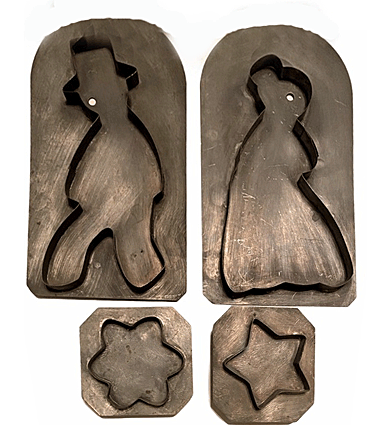 Tin
cookie cutters became available toward the end of the 18th century.
American tinsmiths began making cookie cutters with a full plate on the
back of them while their European counterparts made theirs with just the
outline of the shape. Tin
cookie cutters became available toward the end of the 18th century.
American tinsmiths began making cookie cutters with a full plate on the
back of them while their European counterparts made theirs with just the
outline of the shape.
Tins produced early cookie cutters shaped like hearts, praying hands,
simple animals, and stars. They cut out the tine, shaped it, then
soldered it onto the tin plate backing. Sometimes, they soldered handles
on to the plate. Because solder was costly in the 18th and early 19th
centuries, they typically used just little dabs of solder to hold the
tin together. As solder became less expensive, they used more of it. By
1830, cookie cutters had large welds.
 Tinsmiths
traveled around the country providing tin goods for households. In the
process, they would use scrap tin from other projects to make a cookie
cutter. Each one was unique with slightly different shapes. After the
Civil War, manufacturers began producing cookie cutters with more
standard, more complicated designs. In the 1920s, aluminum became the
preferred material, making the cutters lighter in weight and shiny in
appearance. Tinsmiths
traveled around the country providing tin goods for households. In the
process, they would use scrap tin from other projects to make a cookie
cutter. Each one was unique with slightly different shapes. After the
Civil War, manufacturers began producing cookie cutters with more
standard, more complicated designs. In the 1920s, aluminum became the
preferred material, making the cutters lighter in weight and shiny in
appearance.
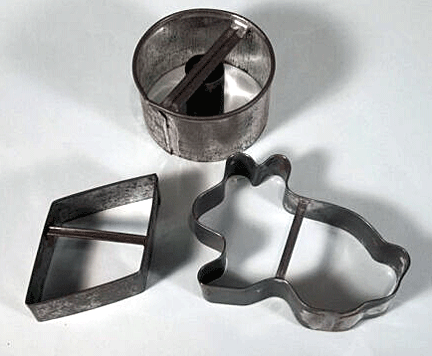 Rural,
itinerant tinsmiths offered less expensive handmade tin cutters in
common shapes of people, animals, stars, spades, and hearts. Rural,
itinerant tinsmiths offered less expensive handmade tin cutters in
common shapes of people, animals, stars, spades, and hearts.
Old tin stands out from modern metals as it’s relatively heavy and thick
and usually darkened in color. These cutters make 3/4-inch to 1 1/8-inch
deep cuts. The back of these cutters were flat and may or may not have
had strap handles. Because tinsmiths tried to conserve every possible
inch of metal they could, older backs were more or less cut to the shape
of the cutting edge. These also have “air holes” or “push holes,” which
helped detach the cookie dough from the cutter.
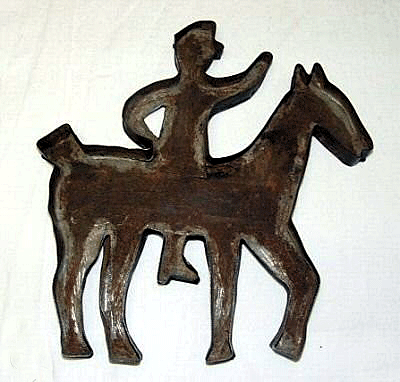 The
first American manufactured cookie cutters appeared after the end of the
Civil War as a result of industries looking to adapt to a peacetime
economy. Manufacturers begau mass-producing metal cookie cutters, and by
the mid-20th century, they had begun to make them of plastic. Vintage
cookie cutters from the last century may have handles made of wood,
metal, or plastic. Aluminum cutters can date to 1900, but are far more
common from the 1930s. Metal cookie cutters with “bullet” handles are
especially sought after by collectors. The
first American manufactured cookie cutters appeared after the end of the
Civil War as a result of industries looking to adapt to a peacetime
economy. Manufacturers begau mass-producing metal cookie cutters, and by
the mid-20th century, they had begun to make them of plastic. Vintage
cookie cutters from the last century may have handles made of wood,
metal, or plastic. Aluminum cutters can date to 1900, but are far more
common from the 1930s. Metal cookie cutters with “bullet” handles are
especially sought after by collectors.
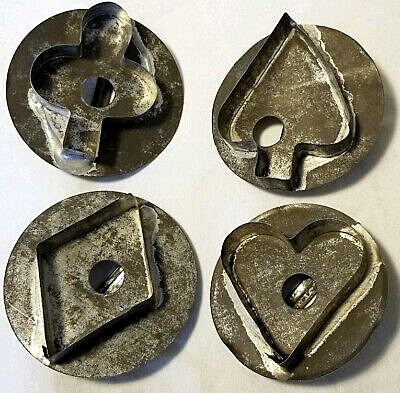 Makers
produced and sold cookie cutters in the shapes of the four suits of
playing cards as sandwich cutters—which have deeper edges than regular
cookie cutters—designed to add whimsy to a poker or bridge party. Some
of the more clever cookie cutters, like the “In-Genia Rotating Cutter”
from West Germany, made several different designs with one rotating
tool. Makers
produced and sold cookie cutters in the shapes of the four suits of
playing cards as sandwich cutters—which have deeper edges than regular
cookie cutters—designed to add whimsy to a poker or bridge party. Some
of the more clever cookie cutters, like the “In-Genia Rotating Cutter”
from West Germany, made several different designs with one rotating
tool.
In England, Tala first offered its pastry-cutter sets in the early 1930s
in painted tins. These tins can be dated by their colors: In the 1930s,
they came in pastels, while the ones from the '50s came in vibrant
colors. Tala tins contain four cutters of varying sizes that fit within
each other, available in plain and ruffled edges. Tala also made a
particularly desirable “Big Top” set of six metal cutters featuring a
penguin, seal, horse, elephant, hippo, and pelican.
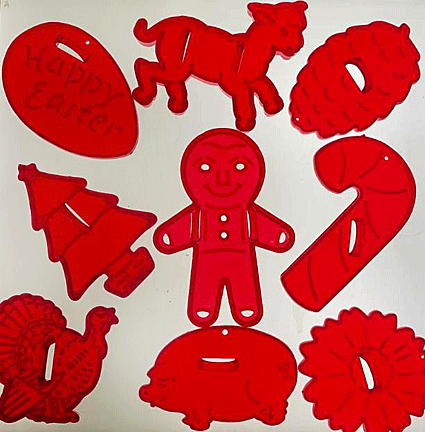 Plastic
cutters from the 1940s make deep cuts and come in transparent red and
green colors. Opaque plastic cutters didn’t really show up until the
1960s, and they tend to make shallower cuts. Shapes include Santas and
bunnies for Christmas and Easter, popular cartoon characters, flags for
the Fourth of July, and profiles of the Statue of Liberty. Licensed
cookie cutters from more recent decades include Looney Tunes, Mario
Brothers, Barbie, and Teenage Mutant Ninja Turtles. Top American makers
of cookie cutters are Ekco, Midwestern Home Products, and Hallmark,
whose cutters from the late '70s and early '80s are relatively
collectible. Plastic
cutters from the 1940s make deep cuts and come in transparent red and
green colors. Opaque plastic cutters didn’t really show up until the
1960s, and they tend to make shallower cuts. Shapes include Santas and
bunnies for Christmas and Easter, popular cartoon characters, flags for
the Fourth of July, and profiles of the Statue of Liberty. Licensed
cookie cutters from more recent decades include Looney Tunes, Mario
Brothers, Barbie, and Teenage Mutant Ninja Turtles. Top American makers
of cookie cutters are Ekco, Midwestern Home Products, and Hallmark,
whose cutters from the late '70s and early '80s are relatively
collectible.
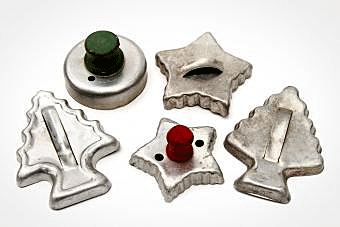 Cookie
cutters are generally made of four materials: stainless steel, copper,
tinplate, aluminum and plastic. For collectors, its usually the tin
examples made by hand that are the most desirable. Classic tin cutters
were hand soldered, while newer, mass-produced cutters are spot welded
together. Cookie
cutters are generally made of four materials: stainless steel, copper,
tinplate, aluminum and plastic. For collectors, its usually the tin
examples made by hand that are the most desirable. Classic tin cutters
were hand soldered, while newer, mass-produced cutters are spot welded
together.
Aluminum virtually replaced tin as the favored material for cutters in
the 1920s. Plastic cutters were mass marketed after World War II.
Starting in the late 1930s, plastic cutters that could be machine-molded
came on the scene, paving the way for mass production. 100-piece plastic
sets for $7.95 or so, plastic can also be valuable at times. Domar's
Alice in Wonderland sets from the 1940s are worth several hundred
dollars.
Collecting Cookie Cutters
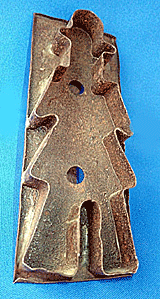 When
it comes to collectibles, however, there's nothing cut and dried about
cookie cutters. There's a huge variety of shapes ranging from the common
ginger-bread boy to antique cars. There are adult-themed Seagram 7
cookie cutters, along with kid-oriented cookie cutters resembling Mr.
Peanut, Snoopy, and cartoon characters such as Tom and Jerry. When
it comes to collectibles, however, there's nothing cut and dried about
cookie cutters. There's a huge variety of shapes ranging from the common
ginger-bread boy to antique cars. There are adult-themed Seagram 7
cookie cutters, along with kid-oriented cookie cutters resembling Mr.
Peanut, Snoopy, and cartoon characters such as Tom and Jerry.
Many people collect cookie cutters for their folk art and decorative
value, not to mention that for some of us they evoke wonderful memories
of baking and holidays. One collector has over 15,000 cookie cutters in
his collection.
While many cookie cutters can be purchased for far less than S10, some
have sold for several thousand. An Uncle Sam cookie cutter brought
$3,000 at an auction in 1989. A 19th century Statue of Liberty cutter
sold for $2,475. One of the highest prices achieved was the $7,400 bid
for Running Slave cutter, a nearly foot-tall running slave figure dated
to the Civil War.
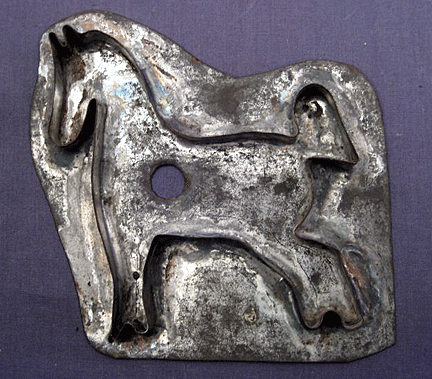 In
general, figurals like chickens and elephants tend to be more valuable
than geometric shapes. The more unusual the shape, the more collectible
the cookie cutter, like those in the form of reindeer, mounted figures,
and clowns. In
general, figurals like chickens and elephants tend to be more valuable
than geometric shapes. The more unusual the shape, the more collectible
the cookie cutter, like those in the form of reindeer, mounted figures,
and clowns.
Antique tin cookie cutters derive their value from availability and
condition in much the same way as other antiques. Look for good
condition in the tin with no holes, rust, or breaks. More solder isn’t
necessarily bad unless it looks like it was a repair. Rare designs
include heart in hand, hand, stags, trees, stylized people, peafowl,
boots or shoes. Any design on larger cookie cutters are worth
more—people, horses, bears, people riding horses are some examples of
these larger ones. More common ones include farm animals, such as
chickens, roosters, pigs, rabbits, dogs, cats, ducks, and simple birds.
 Value
depends on a cutter’s shape and uniqueness of the shape, the amount of
detail, and its age—the older the better. Those in their original
packing or with cards attached add value because collectors are
interested in the history. Soldering repair marks decrease cutter value. Value
depends on a cutter’s shape and uniqueness of the shape, the amount of
detail, and its age—the older the better. Those in their original
packing or with cards attached add value because collectors are
interested in the history. Soldering repair marks decrease cutter value.
A cutter bearing a name is more valuable than one without. Scarcity also
plays a role in determining value.
Oddly shaped cutters such as the one of Abraham Lincoln or one of a
moose with extra large antlers tend to have higher values. Small,
painted wooden handles can also add to the price,
The most valuable cutters date to before the start of the 20th century.
Older cutters may feature a back of odd-shaped scrap, with sharp,
straight edges, minimal soldering, and a rough-hewn hole. Newer models
tend to have backs in the shape of a cookie, seamless soldering , and
hand-safe rolled edges.
< Back to Collecting Archives
Next Article > |
